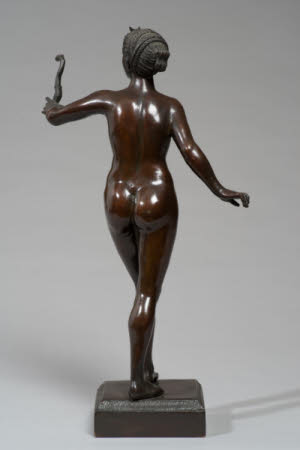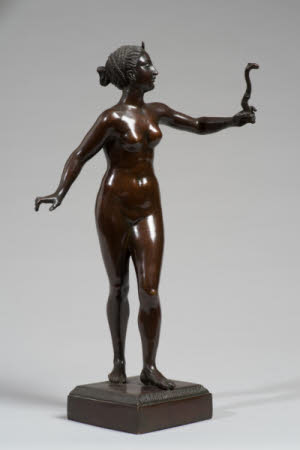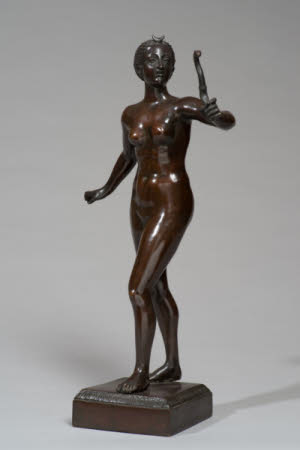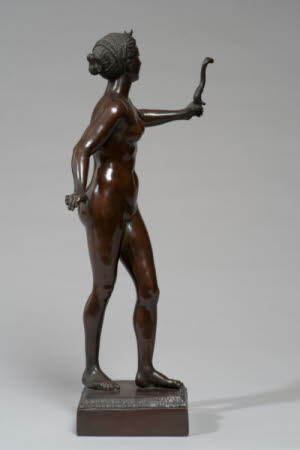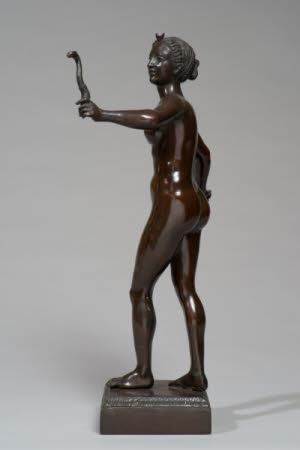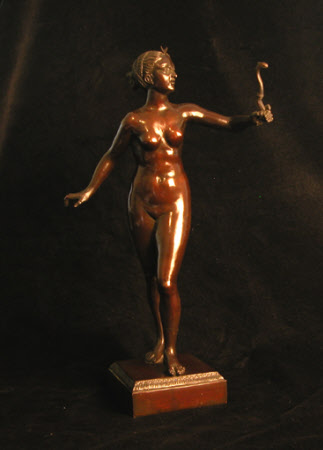Diana
possibly German School
Category
Art / Sculpture
Date
c. 1880 - 1920
Materials
Bronze
Measurements
355 x 193 mm
Place of origin
Germany
Order this imageCollection
Anglesey Abbey, Cambridgeshire
NT 515076
Summary
Bronze, Diana, possibly German School, c. 1880-1920. A bronze statuette of Diana, goddess of the hunt, made around 1900, perhaps in Germany. The figure is identifiable as Diana, who was also goddess of the Moon, through the tiny crescent moon at her temple. She stands naked, left foot forward, right arm stretched out to her side, left arm raised and holding her bow, towards which she turns her head. The end of the bow, lower part of which is broken off, is in form of animal head. Diana’s hair is severely classical in style, drawn back into a bun at the back, and wound into tightly coiled plaits across the top. The figure is fixed to a separately cast rectangular bronze base, with a frieze of palmette ornament along the top edges. A break in left leg, above ankle.
Full description
Statuettes in bronze of Diana, goddess of the Hunt, were popular in the nineteenth and early twentieth centuries, and so are found in some numbers. She is usually depicted, as here, naked and running or walking with her bow in her hand. This example is unsigned, nor is there a stamp for the foundry in which it was cast, which means it is difficult to assess where it might have been made. There is some effort to provide an antique context for the figure, with her hair carefully modelled in an ancient Roman style, and with the frieze of palmette decoration running along the top edges of the base. These features, and her slightly plump figure, suggest that the bronze might have been made in Germany, made in the late nineteenth or early twentieth century. As a rather debased popularising interpretation of the Antique, it may be compared with the small bronze figure of an archer by Julius Schmidt-Felling (1835-1920), also at Anglesey Abbey (NT 5156065). French nineteenth-century statuettes of the goddess Diana tend to be more idealised, for example figures by Alexandre Falguière (1831-1900; Harold Berman, Bronzes and Sculptors 1800-1930, Vol. 2, Chicago 1976, p. 243, no. 812) of c. 1890, or by A.E. Dubucand fils (Berman, Vol. 4, Chicago 1980,p. 923, no. 3522), from c. 1880-1900. Jeremy Warren 2020
Provenance
Acquired by Urban Huttleston Rogers Broughton, 1st Lord Fairhaven (1896-1966) between 1932 and 1940; identifiable in the Anglesey Abbey inventory 1940, p. 51, ‘Cambridge’ Bathroom, valued at £10; bequeathed to the National Trust by Lord Fairhaven in 1966 with the house and the rest of the contents.
Credit line
Anglesey Abbey, The Fairhaven Collection (The National Trust)
Makers and roles
possibly German School, sculptor
References
'Anglesey Abbey, Lode, Cambridgeshire. An Inventory and Valuation of Furniture, Books, Ornamental Items & Household Effects .. prepared for Insurance Purposes’, Turner, Lord and Ransom, April 1940, p. 51. Christie, Manson & Woods 1971: The National Trust, Anglesey Abbey, Cambridge. Inventory: Furniture, Textiles, Porcelain, Bronzes, Sculpture and Garden Ornaments’, 1971, p. 139.
